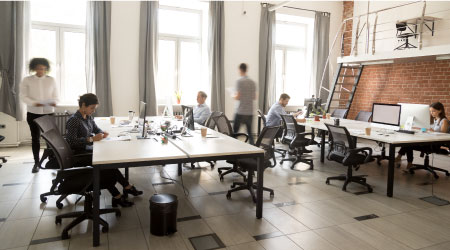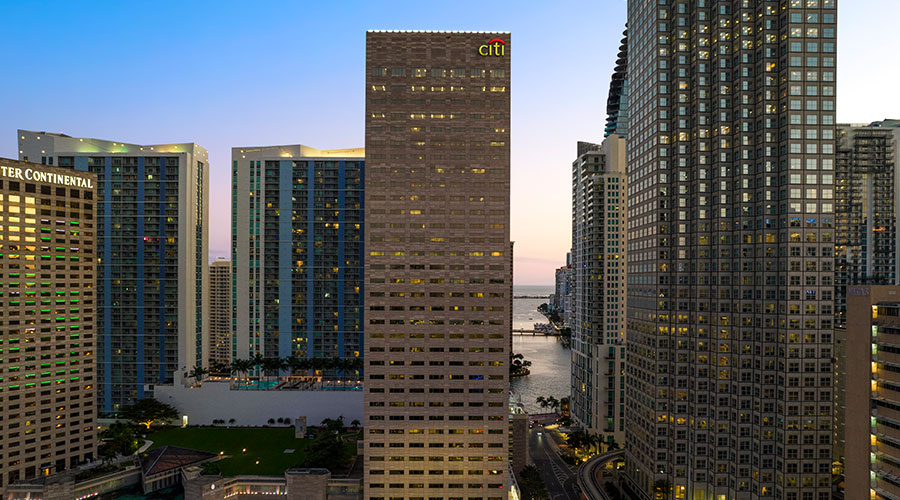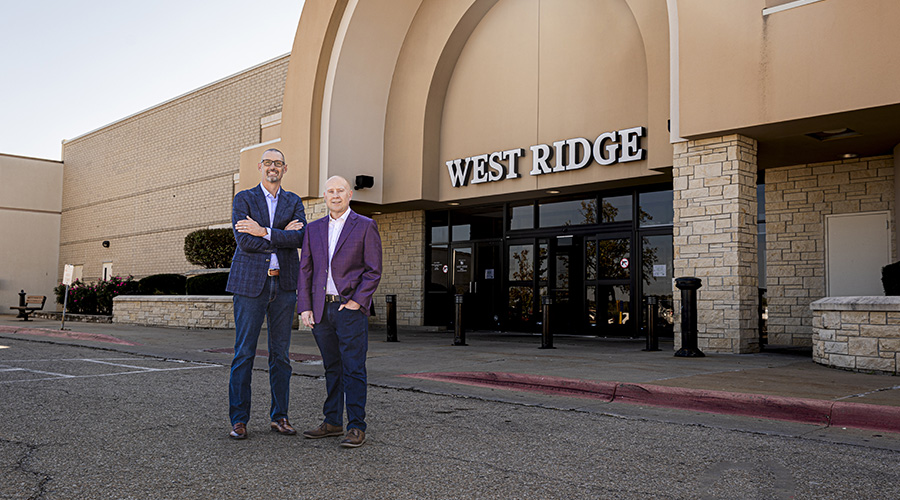How to Plan Office Space When Temporary Becomes Permanent
Here are some strategies for transforming the pandemic workspace away from the traditional office to a more modern hybrid approach.
By Dave Lubach, managing editor
When the pandemic started to impact the U.S. in March 2020, facility managers, like many Americans, probably shared the mindset that the inconveniences would last a few weeks. The country would shut down for a short period, the threat of spreading COVID-19 would go away, and we would all go back to our regular way of life.
The empty institutional and commercial buildings, typically buzzing with employees and other building occupants, would soon return to full or near occupancy. Working from home would become a phrase of the past.
Of course, it hasn’t turned out that way. Days away from the office became weeks. Weeks turned into months. And the months have now dragged into two years. As the country still continues to deal with COVID-19, people continue working from home. In many instances, the trend has become permanent.
In reality, working from home was a runaway train that started growing in popularity before the pandemic, and only picked up momentum during it.
“A lot of people would have liked to work from home, but never had the ability,” says Scott Romick, principal/managing director for Lee + Associates – LA North/Ventura, Inc. “Then COVID pushed everything forward to where we are today.”
Building owners and facility managers are embracing the idea that workers aren’t coming back to the office, as everyone assumed they would when the pandemic eventually waned. While many cubicles, desks and individual offices still sit empty, facility managers are rethinking the concept of work settings for employees when they do step foot inside the office.
Employees stay home
“Desks will be empty.” That was the headline for a recent Gallup article on how many employees, if the opportunity presents itself, would prefer to work from home instead of return to the office in 2022. Gallup predicted there will be a 37 percent reduction of in-person days for employees in the office.
It’s a trend that designers started seeing decades ago. The pandemic has returned it to the forefront.
“Hoteling is a real popular phrase right now,” says Romick of the concept, which refers to the elimination of assigned seating in the workplace. “Back in the ’90s, hoteling was a new concept —tenants trying to reduce their office and real estate costs by having hoteling. I think a lot of companies are trying to figure out if that works.”
The pandemic may have inspired the trend toward temporary workspaces faster than many anticipated, but a younger workforce was already pushing the envelope well before COVID-19 pressed the issue.
“I do think it is more generational,” says Heidi Dunn, a senior associate design lead for Stantec, an engineering service firm. “A younger workforce is more adaptable, more flexible, and has always kind of embraced it more. They were doing it anyway. They will say, ‘OK, I’ll take the meeting at home this morning and come in later.’
“Some people lost their sense of place without having an assigned desk, and I feel like facility managers are having to get back to that, like how can they still give people that sense of culture? That's one of the biggest struggles my clients are going through right now. We have our place, our home, but we still want to have that sense of culture, a place we go to collaborate and still feel like we have a culture.”
Establishing a budget
Transforming a traditional workspace into an area that’s more adaptable for a more mobile workforce takes time, and it won’t happen overnight.
Managers must consider a number of factors when transitioning the workspaces in their facilities.
“Obviously, cost is one of the leading factors associated with it,” says Ali Summerford, an interior design director at Oculus Inc., an architecture and design firm. “We are also unfortunately in a time of supply chain challenges with materials, but I also think that the other side of that allows for a lot more creativity in how to provide solutions, given the nature of availability of those materials, and the cost associated with them.”
One of the first steps Summerford suggests in the process is to secure a contractor and design firm for the project.
“Look at getting a contractor on board sooner rather than later,” she says. “They can look at time overall for the project and get the design team to help with any of the furniture items and learn how creative to be, come up with solutions to meet the schedule, and look at what budget costs are.”
If a building manager is leasing his or her space, look first at what the lease contains, as any plans to go forward with changes might be thwarted.
“You want to know where you are in the duration of that lease,” Summerford says. “If you’re wanting to renegotiate that lease, or you want to consolidate some of that space you’re leasing, you need to look at how much overall square footage you need. You also need to talk about cleaning or any of the maintenance protocols. Obviously, consider the lease and what’s included and not included with amenities.”
Flexibility in spaces
When the pandemic started, the idea of a temporary workspace consisted of spreading out desks for social distancing.
“Everybody was like, ‘What’s the temporary fix? What can we do temporarily?’ and we were like let’s remove some chairs from the conference room and put up some signs because we don’t know how long this will last,” Dunn says. “And then we were going back in and seeing a little more design going into the spaces, whether it was taking down walls and creating a little bit larger conference rooms to have more capacity but still feel socially distant, so we were doing minor renovations.”
As the pandemic continues, the temporary spaces for employees to work for a day or two before returning to working from home are becoming more and more permanent. Consideration was given to designing more collaboration areas and providing more furniture options that are easier to reconfigure inside of a space than completely changing a room by adding or subtracting walls.
“The hybrid schedule was at first where everybody looked once the pandemic started changing from looking at returning to the office to how can we get people back into the office safely,” Summerford says. “Now, I think that whole concept has really shifted to reimagining what is the office space? Regarding flexibility, it is looking at more non-permanent, not your typical drywall construction opportunities, and more furniture-related options to create that flexible environment, which can also help with the cost because then you have that as an asset to reuse within your space.”
A flexible workspace will include all of the elements necessary for employees to meet regardless of whether everyone gathers in the office together or not.
Managers must make sure that their spaces have the proper technology installed so that employees can communicate and work effectively when in the office.
Among the more important factors to consider are:
- Proper software for virtual meetings
- Dependable Wi-Fi
- Visible TV monitors
- Accessible USB ports
- Strong acoustics
“If people are going to be doing virtual calls while they are in the office, they have to have the appropriate headset, and if they are in a conference room the sound system and cameras have to be set up appropriately so that employees aren’t having to carry too much of their equipment back and forth,” Summerford says. “Try to make it as simple as possible that they only have to bring their laptop and maybe not even that.”
All these changes come during a still-challenging time for employees. Dunn says she sees burn out among employees who are growing tired of Zoom meetings and the guessing game of when offices will re-open, will they close again, and how it will affect their work situation?
She encourages facility managers to enter any of the projects keeping employees in mind.
“It goes back to providing a safe space for people to come back to,” Dunn says. “I think not everybody is inclined to just jump back into it. It’s important to focus on the people versus the company. You need your people to feel safe and want to come back.”
Dave Lubach is the managing editor for the facility market team. He has six years of experience writing for the facility management industry.
Related Topics:












